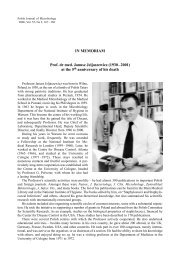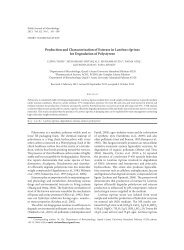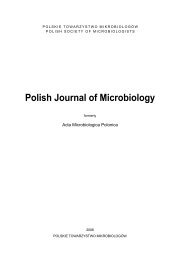No 3 - Polish Journal of Microbiology
No 3 - Polish Journal of Microbiology
No 3 - Polish Journal of Microbiology
Create successful ePaper yourself
Turn your PDF publications into a flip-book with our unique Google optimized e-Paper software.
3 Chitin-glucan production by S. commune<br />
225<br />
Table I<br />
Mycelium yield, CGC content in mycelium,<br />
CGC and schizophyllan production by different S. commune strains<br />
S. commune<br />
strain<br />
Mycelium<br />
yield<br />
g/l<br />
CGC in<br />
mycelium<br />
%<br />
CGC<br />
production<br />
g/l<br />
Schizophyllan<br />
production<br />
g/l<br />
F-795 6.0 ± 0.2 15.2 ± 0.4 0.9 ± 0.1 2.3 ± 0.5<br />
11223 11.0 ± 0.4 17.4 ± 0.2 1.9 ± 0.2 1.7 ± 0.2<br />
1024 8.5 ± 0.1 16.1 ± 0.1 1.4 ± 0.3 0.7 ± 0.1<br />
1025 8.6 ± 0.5 17.1 ± 0.1 1.5 ± 0.2 0.7 ± 0.1<br />
1026 12.3 ± 0.3 20.3 ± 0.3 2.5 ± 0.2 1.2 ± 0.3<br />
127 11.4 ± 0.7 30.2 ± 0.2 3.4 ± 0.4 0.5 ± 0.1<br />
stationary growth phase. S. commune mycelium yield<br />
varied between 6.0 ± 0.2 g/l and 12.3 ± 0.3 g/l (Table I).<br />
For comparison, mycelium yields <strong>of</strong> chitin producers<br />
A. niger and Mucor rouxii are reported about 7 g/l and<br />
5 g/l respectively (Wu et al., 2005; Tan et al., 1996). CGC<br />
content in mycelium <strong>of</strong> different S. commune strains<br />
ranged within 15.2 ± 0.4% and 30.2 ± 0.2% and was<br />
similar to that reported for Aspergillus and Mucor (Wu<br />
et al., 2005, Arcidiacono and Kaplan 1992, Muzzarelli<br />
et al., 1980). CGC production by S. commune reached<br />
3.4 ± 0.4 g/l that is superior to many reported production<br />
values <strong>of</strong> Micromycetes.<br />
The microstructure and chemical composition <strong>of</strong><br />
CGC from S. commune mycelium (Strain 127) were analyzed.<br />
The copolymer was a cotton-like substance white<br />
to creamy in color without odor. Electron-scanning<br />
microscopy showed that even after harsh extraction<br />
that removes alkali soluble cell wall polysaccharides,<br />
CGC from S. commune was composed <strong>of</strong> micr<strong>of</strong>ibers<br />
with diameter 1–2 µm, similar to fungal hypha (Fig. 1).<br />
Highly developed microstructure determined remarkable<br />
swelling capacity <strong>of</strong> the complex that was 18 grams<br />
<strong>of</strong> water per 1 gram <strong>of</strong> CGC and was comparable with<br />
that measured for cotton wool (35 g/l). This characteristic<br />
makes CGC from S. commune a valuable product<br />
for application in bandages.<br />
Elementary analyses <strong>of</strong> the complex showed nitrogen<br />
content 1.22 ± 0.10%, carbon 42.20 ± 0.24% and<br />
hydrogen 6.61 ± 0.15%. Glucosamine in the complex<br />
comprised 4.5 ± 0.4%. When these two analyses were<br />
combined, the composition <strong>of</strong> CGC from S. commune<br />
can be assumed as follows: 16.6% chitin and 83.4% <strong>of</strong><br />
glucan with chitin deacetylation degree 27%. Although,<br />
chitin portion in S. commune CGC is lower than in<br />
A. niger, where chitin content is reported to be about<br />
30% (Wu et al., 2005; Machova et al., 1999), utilization<br />
<strong>of</strong> S. commune for chitin production is promising due<br />
to high CGC yield.<br />
Fungal mycelium separation from cultivation me -<br />
dium is an essential technological step in CGC production.<br />
From this point, filtration <strong>of</strong> S. commune cultural<br />
broth is a rather complicated process due to exopolysaccharide<br />
content. The possibilities <strong>of</strong> CGC production<br />
increase together with exopolysaccharide synthesis<br />
suppression by variation <strong>of</strong> cultivation technique were<br />
studied. The study was conducted on S. commune F-795.<br />
CGC accumulation by fungi can be effected by<br />
nitrogen source in nutrient medium. Sousa et al. (2003)<br />
reported that when Mucor circinelloides was cultivated<br />
in synthetic medium with L-asparagine as single nitrogen<br />
source, chitin content in mycelium depended upon<br />
amino acid concentration. There was studied effect <strong>of</strong><br />
yeast extract (YE) in the medium on CGC production<br />
by S. commune. The amount <strong>of</strong> YE was varied from 2 g/l<br />
up to 5 g/l and CGC content in mycelium, mycelium<br />
yield and schizophyllan synthesis were measured. It<br />
was found, that CGC content in S. commune mycelium<br />
is little affected by YE, and it varied in the range<br />
<strong>of</strong> 15.4 ± 0.3% under all studied YE concentrations.<br />
Increase <strong>of</strong> YE content from 2 to 4 g/l increased mycelia<br />
biomass production more than 1.5 times (Fig. 2). Further<br />
supplementation <strong>of</strong> the medium with YE increased<br />
mycelium growth only slightly. As distinct from mycelium,<br />
schizophyllan synthesis was suppressed by YE<br />
concentrations over 4 g/l (Fig. 2).<br />
Amorim et al. (2001) reported medium pH as<br />
a regulating agent for chitosan production by Mucor<br />
racemosus and Cunninghamella elegans. The effect can<br />
be due to chitin deacetylase activity modification. It<br />
can be expected that medium pH may effect activity<br />
<strong>of</strong> enzymes, involved in S. commune CGC formation<br />
as well. CGC production by S. commune in medium<br />
with different initial pH was studied. Again, CGC<br />
Fig. 1. Electron-scanning microscope image <strong>of</strong> CGC<br />
from S. commune submerged mycelium (High voltage 5 kV, working<br />
distance 4.4 mm, magnification × 5000).






